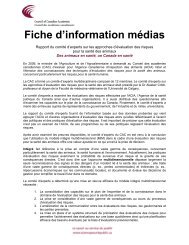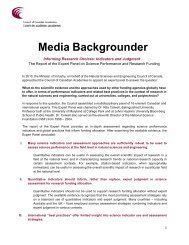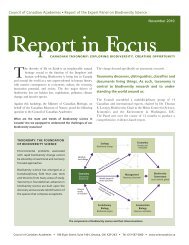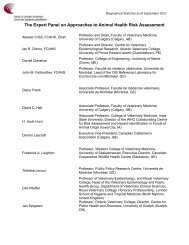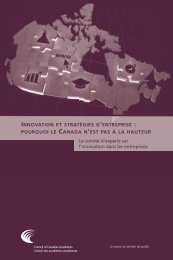an assessment of the evidence - Council of Canadian Academies
an assessment of the evidence - Council of Canadian Academies
an assessment of the evidence - Council of Canadian Academies
- No tags were found...
Create successful ePaper yourself
Turn your PDF publications into a flip-book with our unique Google optimized e-Paper software.
14 Influenza Tr<strong>an</strong>smission <strong>an</strong>d <strong>the</strong> Role <strong>of</strong> PPRE: An Assessment <strong>of</strong> <strong>the</strong> EvidenceGlossary <strong>of</strong> Key Terms Used in this Report*Particle: Generic term for a small mass <strong>of</strong> ei<strong>the</strong>r liquid or solid.Droplet: A droplet is a specific type <strong>of</strong> particle. It refers to a small volume <strong>of</strong> liquid thatis expelled during breathing, talking, sneezing or coughing <strong>an</strong>d which contains assortedbiological/biochemical components.Droplet Nuclei: Particles that are formed by evaporation <strong>of</strong> droplets leavingnon-volatile components.Aerosol: The suspension in air (or in a gas) <strong>of</strong> solid or liquid particles that are smallenough to remain airborne for prolonged periods <strong>of</strong> time.Aerodynamic Diametre: Term used to st<strong>an</strong>dardize how particles <strong>of</strong> different shapes<strong>an</strong>d densities behave in <strong>the</strong> air <strong>an</strong>d how fast <strong>the</strong>y will fall to <strong>the</strong> ground under <strong>the</strong>combined influence <strong>of</strong> air resist<strong>an</strong>ce <strong>an</strong>d gravity (settling velocity). A particle has <strong>an</strong>aerodynamic diametre “d” if its settling velocity equals that <strong>of</strong> a spherical water droplet<strong>of</strong> diametre “d”.Ballistic Particles: Particles greater th<strong>an</strong> approximately 100 µm in diametre. A “µm”or micrometer, is 10 -6 m.Inhalable Particles: Particles between 0.1 <strong>an</strong>d 100 µm in diametre.Nasopharyngeal-sized Particles: Particles having diametres in <strong>the</strong> r<strong>an</strong>ge <strong>of</strong>approximately 20 to 100 µm in diametre. They tend to travel no fur<strong>the</strong>r th<strong>an</strong> <strong>the</strong> upperrespiratory tract.Tracheobronchial-sized Particles: Particles having diametres <strong>of</strong> approximately 10 to20 µm. They are capable <strong>of</strong> depositing as far down as <strong>the</strong> tracheobronchial region.Alveolar-sized Particles: Particles having diametres <strong>of</strong> less th<strong>an</strong> approximately10 µm in diametre. They are <strong>the</strong> only particles capable <strong>of</strong> reaching <strong>the</strong> alveolar regionbut c<strong>an</strong> be deposited <strong>an</strong>ywhere in <strong>the</strong> respiratory tract.Fomite: Any in<strong>an</strong>imate object or subst<strong>an</strong>ce capable <strong>of</strong> carrying infectious org<strong>an</strong>isms(such as germs or parasites) <strong>an</strong>d hence, <strong>of</strong> tr<strong>an</strong>sferring <strong>the</strong>m from one individual to<strong>an</strong>o<strong>the</strong>r.Inhalation Tr<strong>an</strong>smission: A mech<strong>an</strong>ism <strong>of</strong> tr<strong>an</strong>smission via inhalation <strong>of</strong> infectiousparticles into <strong>the</strong> respiratory tract. This includes particles r<strong>an</strong>ging in size fromapproximately 0.1 to 100 µm <strong>an</strong>d <strong>the</strong>refore would encompass <strong>the</strong> classical airborne<strong>an</strong>d droplet modes <strong>of</strong> tr<strong>an</strong>smission.





